Electric boiler for heating: versions, installation
How is the heating electric boiler of one type or another? How to choose a device of optimal power? How to connect it to the power supply and pipes with coolant? Finally, are there economical electric boilers for heating? Let's try to figure it out.
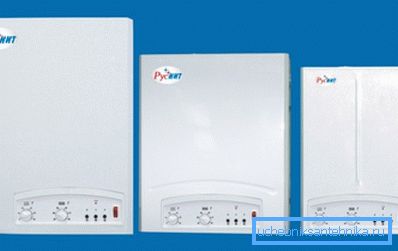
Device
On sale you can find heating boilers of three types, fundamentally different way to convert electricity into thermal energy.
Tenovye
Heating of water or other heat carrier is carried out in a flow tank of stainless or enameled steel, in which several tubular electric heaters are placed. The contact terminals of the heaters are, of course, outside the tank. The heating elements are connected to a control circuit that allows stepwise control of the heating power.

Curiously: all modern industrial and domestic electric boilers for heating are supplied with thermostats that regulate the power depending on the temperature of the heat carrier. Many devices have the ability to connect a remote temperature sensor that allows you to bind the power control to the room temperature.
In addition to the actual tank with heating elements, in the boiler body can usually be found:
- Circulation pump (often - with the ability to adjust performance).
- Pressure gauge and safety valve, relieving pressure in the circuit when the calculated value is exceeded.
- Automatic air vent.
- Optional Expansion Tank, compensating for an increase in the volume of coolant during heating.
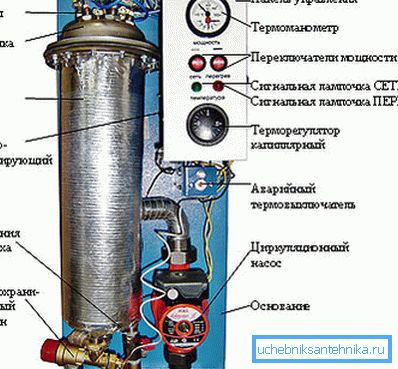
The control circuit not only adjusts the power stepwise depending on the temperature of the coolant, but also completely stops the power supply when overheating (in particular, when the circuit is depressurized).
Electrode
Probably, many readers have been able to use or even see homemade boilers from a pair of razor blades. They are carried by an insulating pad for a short distance (up to 5 mm), after which they are powered and the whole structure is immersed in water.
Since tap water is a solution of numerous salts, it conducts electricity; due to the fact that the concentration of salts is relatively small, it has a rather high electrical resistance. Accordingly, the layer of water between the electrodes behaves like a normal resistor - it heats up when energized.
We have just described the work of the Galan electrode boiler (sometimes the company's products are mistakenly called Galant). It heats the water indirectly - by transferring heat from tubular heaters to it - but directly: the coolant itself becomes a resistor through which current flows.
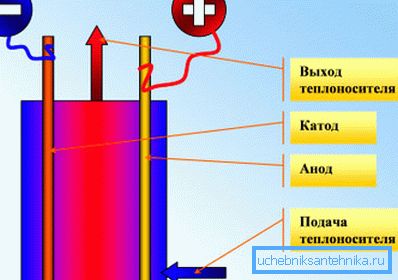
Curiously: at positive temperatures, water behaves according to all the canons of physics; in honesty, it expands when heated. Due to the displacement of warm water in the upper part of the circuit with colder masses with a small length of the electric boiler circuit, the heating electrode can do without circulation pumps.
Induction
The phenomenon of electromagnetic induction is called the excitation of induced currents in a conductor placed inside the inductor. (See also the article Solar collectors for home heating: features.)
If the conductor is the same coil, then it can be removed from the voltage, which will be correlated with the voltage on the first coil in the same proportion as the number of turns of the wire in them. This is how any electrical transformer works.
If the inside of the inductor turns out to be a monolithic core, then it will simply start to warm up with induced currents. In this case, the dielectric materials separating the coil and the core, will not affect the heating of the latter.

Understanding the principle of operation allows us to make the simplest induction boiler with our own hands. It is enough to fix the steel bar in a plastic water pipe in any way so that it does not touch its walls, and then wind the coil of copper wire over the pipe. Arranging the circulation of water through the pipe, we get its stable heating. (See also the article Biofuels for fireplaces: features.)
Advantages and disadvantages
How good are electric boilers against competing solutions? Do they have significant drawbacks?
General features
- Direct heating of the coolant with electricity is the most expensive source of thermal energy of all mass applied. In order not to be unfounded, let the reader independently compare costs.
| Heat source | Price kilowatt-hour heat, rubles |
| Main gas | 0.7 |
| Firewood | 1.1 |
| Coal | 1,3 |
| Pellets | 1.7 |
| Liquefied gas (gas tank) | 2.0 |
| Liquefied gas (cylinders) | 2.8 |
| Solarium | 3.2 |
| Electricity | 3.6 |
- The electrical power consumed by the boiler may not be provided everywhere. For example, the full-fledged heating of a dacha of a large area is difficult to realize simply because the typical power limit for a dacha that is provided by aluminum wiring of a garden community is 2-2.5 kW.
- However, the use of electricity ensures the maximum degree of user comfort. The boiler does not require maintenance and is able to work for months in a completely autonomous mode. The owner does not need to care about the storage and transportation of fuel, its storage, removal and disposal of combustion products.

In addition: the electrical control circuit allows, if desired, to expand the functionality of the boiler with a GSM module, a remote control panel, a programmable timer, etc.
- The average price of electric heating devices is noticeably lower than gas or solid fuel. The reasons are the relative simplicity of the design and the low material consumption of production.
In addition to the general qualities, each type of equipment has its own pros and cons.
Tenovye
Their main advantage from the point of view of the buyer is that he gets an all-in-one solution. The entire piping of the electric heating boiler is already in its case: it is enough just to connect the outlet pipes to the heating circuit.
The main problem of TEN devices is the gradual formation of scale on the surface of the heaters, which can lead to overheating and failure. However, in the closed circuit of an autonomous heating system, this problem is not too acute: after precipitation of all salts dissolved in water, there is no place for new ones to come from.
Electrode
They have two important advantages:
- Compact. A low-power device of this type will perfectly fit under the window sill or behind the toilet.
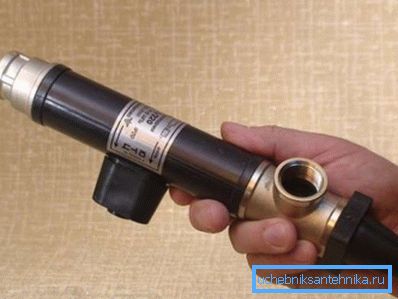
- Absolute security. When the circuit is depressurized, the heating will stop not due to the activation of the automation, but simply due to the principle of operation of the device: in the absence of a conductor between the electrodes, the current will cease to flow.
Without the minuses, too, not done.
- Due to the detachment of charged particles from their surface, the electrodes gradually dissolve and require replacement.
- The boiler is able to work with only one coolant - water. Not only that: its composition must comply with GOST 2874-82 Drinking water. Hygienic requirements.
Induction
In this case, security is somewhat worse: induction works in any environment. The main advantage of the induction scheme is that the boiler is practically eternal.
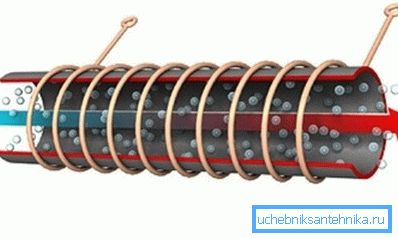
Judge for yourself:
- There is not a single moving part in it.
- Conductive circuits are not in contact with the coolant and, accordingly, are not subject to erosion and electrochemical processes.
- Scale on the core will not affect its performance in any way: it can only be damaged by heating to the melting point of steel (approximately 1100 ° C), which is unattainable in real conditions.
By the way: the excitation of eddy currents causes a weak vibration of the core, destroying scale.
Installation
Boilers with an electrical capacity of more than 7 kW require the presence of 380 volts, which are supplied from the shield with a separate cable.
A typical scheme for connecting an electric heating boiler to the network includes:
- RCD (residual current device) at the entrance to the house.
- Three-phase automatic directly in the boiler power supply circuit.
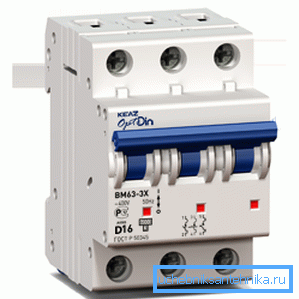
No stabilization is usually required. The voltage at the input to the heating elements is indifferent, and the control electronics is supplied with its own switching power converters.
What does the connection of the electric boiler to the heating system look like? For the TEN boiler, as already mentioned, it is sufficient to simply connect the flow and return flow of the circuit: all the strapping is inside it. In case of dismantling, shut-off valves are installed at the entrances.
Nuance: the heating system may need an additional expansion tank. The total volume of expansion tanks should be approximately equal to 10% of the volume of coolant.
Induction and electrode boilers require installation:
- Expansion tank.
- Circulation pump.
- Safety groups consisting of a pressure gauge, a safety valve and an air vent.
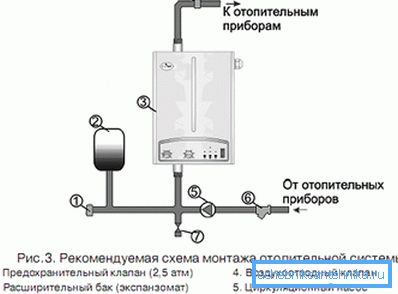
Power
What is the calculation of the power of an electric heating boiler for a house of a known size? Here is a simple instruction.
The base value is taken as 60 watts per cubic meter of the internal volume of the heated room. 200 watts are added to each door, 100 to the window. In addition, a regional factor is used:
| Region | Coefficient |
| Krasnodar region, Crimea | 0.7 - 0.9 |
| Moscow and Leningrad regions | 1.2 - 1.3 |
| Siberia, the Far East | 1.5 - 1.6 |
| Yakutia, Chukotka | 2 |
So, for a house of 75 m2 with three-meter ceilings, two doors and four windows in the Crimea, the calculation will be (75 * 3 * 60 + (2 * 200) + (4 * 100)) * 0.7 = 10010 watts.
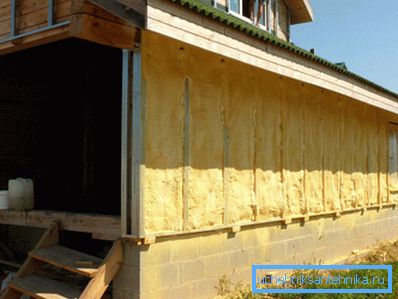
Efficiency
Many sellers are actively advertising economical electric boilers for heating, allowing to reduce the cost of maintaining heat by 1.5 - 2 times. It is emphasized that the devices have the highest (up to 98%) efficiency, which favorably distinguishes them from competing solutions. As an economical solution, induction and electrode boilers are usually presented.
Is advertising true?
Let's think whether any design features or technical characteristics can affect the laws of physics.
- When a heating device of any type is operating, no useful work is accomplished: not a single object with a nonzero mass moves against the gravity vector.
- Consequently, all the energy spent is ultimately converted into acceleration of the motion of the molecules of the medium. Those. in heating.
Again: The efficiency of any electric appliance of direct heating is 100%.
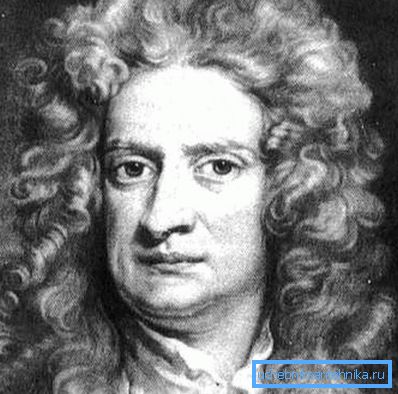
Another thing is that, due to the design features of the boiler, part of the heat energy can be transferred not to the coolant, but to the surrounding air. However, when the boiler is located in a heated room, it will again go to heat the house.
The conclusions are obvious. The assertion that one electric heater is more economical than the other is ordinary disinformation.
Conclusion
We hope that the information offered to the reader will help the reader in the selection and installation of heating equipment. As always, you can find additional materials in the video in this article. Successes!